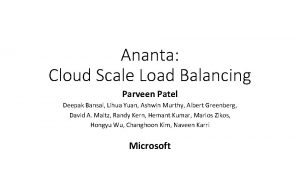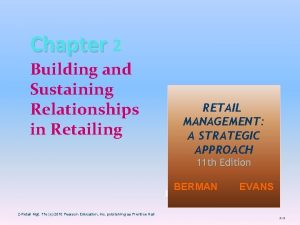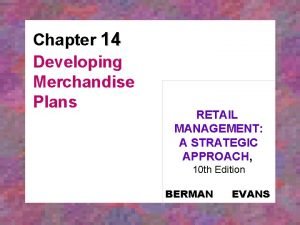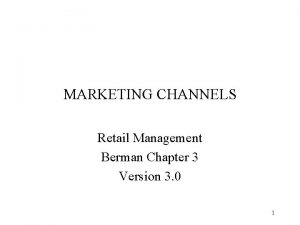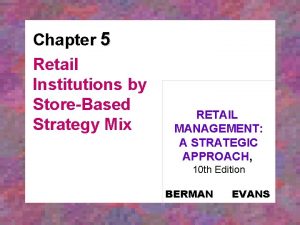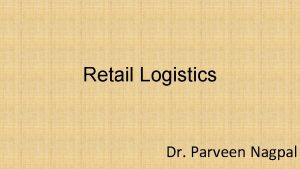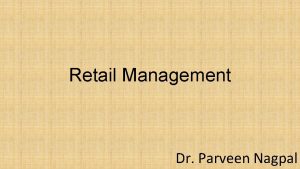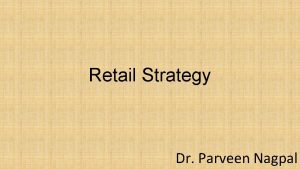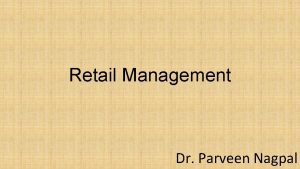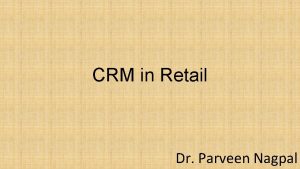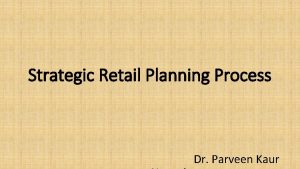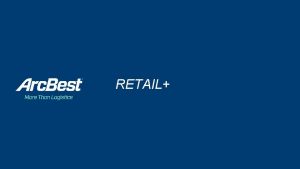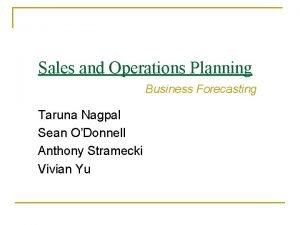I T in Retail Dr Parveen Nagpal I



















- Slides: 19

I. T. in Retail Dr. Parveen Nagpal

I. T. in Retail • With the increasing globalization of retailing, use of information technology (IT) in the retail sector has increased significantly. • I. T. plays an increasingly important role in the management of complex retail operations. • The development of mobile commerce or M-commerce enables businesses and consumers to transact without having the access to a wired computer. • The increasing use of smart phones and tablets offer the retailers the opportunity to reach out and sell to consumers anytime and anywhere. • The spread of internet has opened up a number of opportunities for using I. T. innovatively. • The development of information technology enabled services has facilitated the retail sector in numerous ways.

I. T. in Retail Lowe and Wrigley (1996) suggest that since the 1970 s there have been three main ways in which retailers have used I. T. : 1. Investment in I. T. along with organizational changes, improved retail logistics, reducing delivery lead times, resulting in a progressive reduction in retailer inventory holdings; 2. better information about consumer demand supported retail policies in own-brand, product development, and the refocusing and redefinition of many of the most successful firms. 3 cutting labor costs by effective staff scheduling and by using more parttime staff. Retailers use I. T. to measure staff performance, enabling costs to be further reduced with the help of better information about transactions and performance levels. Thus I. T. is having a major impact on the modern retail business.

Importance/ Advantages of I. T. in Retail • Efficient Stocking of Merchandise • Collection of Data • Efficiency of Operations • Helps Communication Limitations of I. T. in Retail • Implementation Expenses • Security Issues • Unemployment

Factors Affecting the use of I. T. in Retail • Scale and Scope of Operations • Financial Resources Available • Nature of Business • Human Resources Available

I. T. in Retail • Database: A database is a computer system used to store and analyse large volumes of data. Data relating to item sales, customer information, and the range of goods bought by customers can be held on a database and used for marketing purposes. • Database Management: The use of systems to organize, retrieve, search and manage data, collected about the stores customers, vendors, products Its elements are: üData Warehousing: Large systems collecting internal information from inside the company (such as electronic point of sale, loyalty cards, and customer services) and external information from other organizations (such as third party suppliers, competitor information and market research). These data are usually stored in a separate computer system so that the data warehouse does not interfere with normal day-to-day operations.

I. T. in Retail • Data warehouses also contains detailed information about customers, which is used to target promotions and group products together in stores. • Data warehouses are being used to strengthen the relationships with their customers and improve the productivity of their marketing and inventory management efforts. üData Mining: Data mining involves extracting and analysing different types of data to detect patterns that are not immediately obvious. Data mining and analysis will permit data to be organized to assist customer segmentation and CRM process.

Electronic Data Interchange (EDI) • In the past, retailer-vendor information flows were accomplished by sending handwritten or typed documents through the mail or by fax. • Now most communications between vendors and retailers occur via electronic data interchange. • Electronic data interchange (EDI) is the computer-to-computer exchange of business documents in a standardized format. • It facilitates exchange of electronic documents between organizations, thus the acronym EDI is also interpreted as Electronic Document Interchange. • To facilitate the adoption of EDI, the retail industry agreed to use specific symbols to delineate the purchase order number, vendor’s name, address the merchandise is being shipped to etc.

Electronic Data Interchange (EDI) • Retailers have developed standards for exchanging information about purchase order changes, order status, transportation routings, advance shipping notices, on-hand inventory status, and vendor promotions, as well as information that enables vendors to put price tags on merchandise. • The development and use of these standards is critical to the use of EDI because they enable all retailers to use the same format when transmitting data to their vendors. • EDI transmissions between retailers and vendors occur over the Internet, and to help secure information, retailers have incorporated security policies, that is, set of rules that apply to activities involving computer and communication resources that belong to an organization. • Retailers train employees and add necessary software and hardware to enforce the rules.

Advantages of EDI • Saves time – immediate transmission of data • Reduces costs – paper handling, filing, storing • Reduce manual typing errors • Shorter lead times • Improves relationships between retailer and supplier

Radio frequency identification (RFID) • Radio frequency identification (RFID) is a technology that allows an object or person to be identified at a distance by means of radio waves. • The RFID devices or tags are attached to containers, shipping cartons, or even behind labels on individual items. They then transmit data about the object in which they are embedded. • The RFID technology has two advantages over bar codes: i. The devices can hold more data and update the data stored. For instance, the device can keep track of where an item has been in the supply chain and even where it is stored in a distribution center. ii. The data on the devices can be acquired in harsh environments without a visual line of sight - an environment in which barcode labels won’t work. Thus, RFID enables the accurate, real-time tracking of every single product, from manufacturer to checkout in the store.

Radio frequency identification (RFID) • RFID can significantly decrease warehouse, distribution, and inventory costs; increase margins; and provide better in-stock positions. • Data about an item or carton can be encoded into an RFID chip and then can be accessed remotely to determine the presence of the item and where it is. • However, to meet these demands, vendors have been forced to make significant investments to acquire the necessary technology and equipment. • A major obstacle to the widespread adoption of RFID has been the high costs, which make the present return on investment low. • Several retailers like Wal-Mart, Metro, etc. have made it mandatory for their suppliers to tag shipments and goods coming into distribution centres and stores with RFID tags, within a fixed time frame

Advantages of RFID • Reduced warehouse and distribution costs • Reduced point-of-sale labour costs • Inventory savings • Elimination of counterfeit merchandise • Reduced theft • Reduced out-of-stock condition

Vendor-managed inventory (VMI) • Vendor-managed inventory (VMI) is an approach for improving supply chain efficiency in which the vendor is responsible for maintaining the retailer’s inventory levels. • The vendor determines a reorder point - a level of inventory at which more merchandise is ordered. • The retailer shares sales and inventory data with the vendor via EDI. • When inventory drops to the order point, the vendor generates the order and delivers the merchandise • In ideal conditions, the vendor replenishes inventories in quantities that meet the retailer’s immediate demand reduce stockouts with minimal inventory.

Vendor-managed inventory (VMI) • Vendor salespeople no longer need to spend time generating orders on items that are already in the stores, and their role shifts to selling new items and maintaining relationships. • Retail buyers and planners no longer need to monitor inventory levels and place orders. • The sharing of POS transaction data, for instance, allows vendors to sell merchandise on consignment; the vendor owns the merchandise until it is sold by the retailer, at which time the retailer pays for the merchandise. • Consignment selling provides an incentive for the vendor to pick SKUs and inventory levels that will minimize inventory and generate sales. • Because the vendor is bearing the financial cost of owning the inventory, retailers are more willing to allow the vendor to be responsible for determining the inventory plan and appropriate assortment for each store.

Vendor-managed inventory (VMI) • Although it is a more advanced level of collaboration than simply using EDI and sharing information, VMI has its limitations. • While the vendor coordinates the supply chain for its specific products, it does not know what other actions the retailer is taking that might affect the sales of its products in the future. • For example, Pepsi might not know that a supermarket will be having a big promotion in three weeks for a new beverage introduced by Coca-Cola. Without this knowledge, Pepsi would ship too much merchandise to the supermarket • Advantages of VMI: üBetter control to forecast demand üReduce inventory costs üStrengthen customer-vendor relationships

Collaborative Planning, Forecasting and Replenishment (CPFR) • In the 1990 s, big retailers (beginning with Walmart) and their consumer goods partners identified unmet potential in forecast accuracy, supply chain coordination, and general supply chain visibility. Their awareness gave rise to Collaborative Planning, Forecasting, and Replenishment, an end-to-end supply chain scheme designed to close the loop in the consumer-goods-to-retail supply chain. • Collaborative planning, forecasting and replenishment (CPFR) is the sharing of forecasts and related business information and collaborative planning between retailers and vendors to improve supply chain efficiency and product replenishment. • Although retailers share sales and inventory data when using a VMI approach, the vendor remains responsible for managing the inventory.

Collaborative Planning, Forecasting and Replenishment (CPFR) In contrast, CPFR is a more advanced form of retailer-vendor collaboration that involves sharing proprietary information such as business strategies, promotion plans, new product developments and introductions, production schedules, and lead-time information. Advantages of CPFR • Facilitates flexible relationships • Decrease in inventory levels and safety stocks • Decrease in storage and financing costs • Decrease in obsolescence • Reduction in stock-outs and opportunity costs • Sales increase from improved customer service • Improvements in forecast accuracy

References 1. Michael Levy & Barton A Weitz, “Retailing Management”, 8 th Edition, Tata Mc Graw Hill. 2. Swapna Pradhan, “Retailing Management – Text and Cases”, 5 th Edition, Tata Mc Graw Hill. 3. Nagpal, Sharma “Retail Management”, TYBMS, Sheth Publishers 4. Nagpal, Sharma “Retail Management”, M. Com, Vipul Prakashan.
 Bpwn
Bpwn Parveen
Parveen Vinayak nagpal
Vinayak nagpal Dr rajeev nagpal
Dr rajeev nagpal Dr anish nagpal
Dr anish nagpal Radhika nagpal
Radhika nagpal Communication mix in retail
Communication mix in retail Human resource management in retailing
Human resource management in retailing Retail environment ppt
Retail environment ppt 5 promotional tools
5 promotional tools Leased department example
Leased department example Retail chain
Retail chain Building and sustaining relationships in retailing
Building and sustaining relationships in retailing Mtel philosophy
Mtel philosophy Fashion promotion definition
Fashion promotion definition Characteristics of retail
Characteristics of retail Charity retail association
Charity retail association Unit 5
Unit 5 Retail strategy mix
Retail strategy mix Retail management strategy
Retail management strategy

